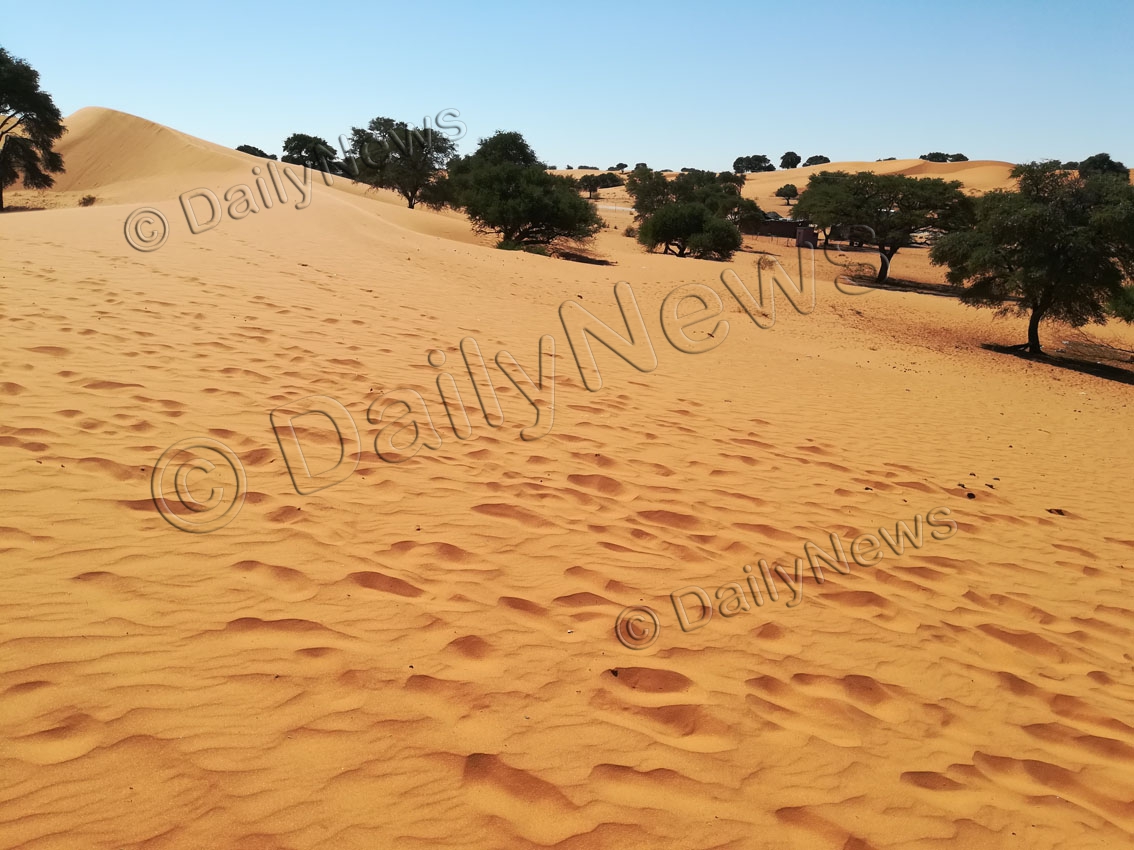Botswanas quintessential wilderness safari
06 May 2019
It is the wee hours of the morning as I lace up my boots to head for a small, yet beautiful village of Khawa.
For a first timer relishing for adventure and daring to buckle up to enter uncharted terrains, the drive into the village is nothing but wonder.
One has to traverse the desert on an uneven gravel road with a 4 X 4 Land Cruiser to reach this breath taking village lying in the heart of the Kalahari Desert.
Endowed with wavy, soft brown sand dunes, Khawa is approximately 167km south west of Tsabong in the untouched Kgalagadi District.
To get here, one travels about 90 km on a tarred road, while the rest of the journey is through the untapped and pristine nature vegetation characterised by deciduous trees, mostly dark green acacia trees, low shrubs and tussock grass, beautifully embedded under clear blue skies.
During the drive, the excursion turns into a thrilling experience as the team occasionally bumps into awe inspiring wild animals such as meer cats, rabbits, guinea fowls, ostriches and a spectacle of springboks that now and again forces the driver to slam on the brakes to give way.
Meanwhile, the driver effortlessly negotiates twists and turns of the road and steep curves, which makes the journey unique.
Slowly, it dawns on me that for those who relish pristine and untamed safari, Khawa could well be the best place, with its vast landscape with diverse natural resources.
The small village is situated within a great sand deposit, which towers forming crescent like patterns giving it a fascinating wilderness unique appeal.
After the thrilling two-hour drive, we enter the village and feast our eyes on sand dunes at close range.
The dunes lures one to scale up and without waisting time we clamber up to enjoy the view of the village.
The temptation to remove my shoes for a brief walk on the sand dunes takes a toll on me as I sit there imagining and delighting in nature’s beauty, rubbing the soft brown grains against my palms and listening to my heratbeat.
Interestingly, as I stand up I realise my white cargo pants are still as white, not even a single stain from the patch of sand I sat on.
I head to the village Kgotla where I find Kgosi Piet Manyoro ready to share the history of the village.
Kgosi Manyoro, who is the first chief to ascend to the chieftainship throne of the village by vote in 1989, says the village has been gradually developing over the years.
He says according to 2011 population census, the village had recorded 840 people of Batlharo, Bakgothu, Nama and coloured descent.
The economic backbone of the small village revolves around livestock farming.
These subsistence farmerrs acquire livestock through government programmes and policies such as LIMID, ISPAAD.
Other government programmes that keep the village alive are poverty eradication, Ipelegeng and a village cooperative, which was established in 1995 as well as tuck shops.
There are no major supermarkets in the village.
Kgosi Manyoro appreciates the establishment of the renowned Khawa Dune Challenge, which is run by Botswana Tourism Board in collaboration with Ministry of Youth Empowerment, Sport and Culture Development which will be in its 8th year and runs from May 10-13, 2019.
He says the annual event helps to keep poverty at bay as the proceeds are used by Khawa Development Trust to come up with sustainable projects to help villagers in the long run.
“They have bought Karakul Sheep and currently kraaled at Lobu Farm. The trust has fenced a farm where the Karakuls will be reared for export,” he says.
According to Kgosi Manyoro the trust is making strides albeit slowly.
He says Kgalagadi District Council has drilled four water boreholes at Khawa Development Trust Karakul farm, which were still in the first phase as they were awaiting pumps installations.
Kgosi Manyoro and eight villagers would later jump into the Toyota Land Cruiser to take us on an adventurous game drive into the triplets’ park located about 40 km away from Khawa such as Mogojwane Pan, Wolwe Pan and
Konka Pan; a territory where lions roar, leopards, cheetahs, gemsbok, antelopes and a host of other wildlife balance the symbiosis of the ecosystem of the park.
From a bird’s eye view, the sight of dry pans is a sad reality and the use of modern technology to draw underground water for wild animanls has become handy.
As we peruse through the wilderness safari, villagers jump out of the vehicle to examine fresh lion spoors
Their interest was aroused as they took turns to guess where the lion could have headed.
I could feel their excitement as they also enjoyed the adventure of the thrilling game drive venturing into the jungle in the open safari vehicle, which cruised through the wilderness with ease.
Kgosi Manyoro occasionally pokes them, “Banna wee lo tloga lo tla go tlala ka fa pele ka fa lo ipatlela phatlha fa tau e ka tlhagoga fa, bangwe ba lona ba tloga ba taboga thata ba kolobetsa marokgwe fa tau e ka tlhagoga ka fa,” he smiled and the adventure continues.
The lion spoors shows that the king of the jungle was heading to Mogojwane Pan to either quench or hunt prey.
Meanwhile, Kgosi expresses worry at the gradual decrease of wildlife in the park.
He says due to severe drought, wildlife migrated to neighbouring countries and never returned to Kgalagadi as some game farmers in those countries trapped them in their farms.
This, he says affects tourism as tourists do not get to view enough wildlife in the untouched Kgalagadi wildness.
He admits that while some animals were lost to poaching, most were lost to wildlife migration.
He calls for a bigger boarder fence to be erected to keep the wildlife in the country and more water boreholes to be drilled to ensure that animals have sufficient water supply throughout the year. Ends
Source : BOPA
Author : Calviniah Kgautlhe
Location : Khawa
Event : Interview
Date : 06 May 2019







